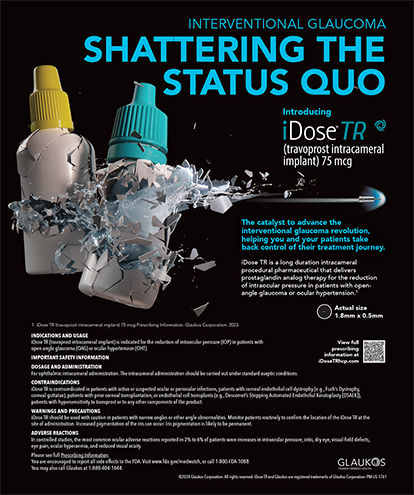The introduction of femtosecond lasers into ophthalmology ushered in a completely new way of creating corneal incisions. The technology's first established use was for the creation of LASIK flaps, but the technique's flexibility and accuracy led to the laser's use for various corneal procedures such as astigmatic keratotomy (AK), corneal incisions during cataract surgery, and corneal grafts.1 Compared with some manual techniques, laser incisions are more precise, reproducible, accurate, and easy, thanks to the customization of their depth, placement, and orientation.
PERSONAL EXPERIENCE
In addition to routine flap creation, my colleagues and I commonly use a femtosecond laser for intrastromal AK in our practice. Although this technique was mostly described in patients with high (eg, postkeratoplasty) astigmatism,2,3 we have found it useful in complicated cases involving low amounts of postoperative mixed astigmatism.4 Normally, these patients have a residual refractive error after previous refractive surgery but cannot undergo other types of surgery (eg, laser ablation). AK seems to be a sensible option for the treatment of mixed astigmatism: the procedure flattens the incised meridian while steepening the opposite meridian (the so-called coupling effect),5 and it corrects both the spherical and cylindrical components of refraction. Performing intrastromal nonpenetrating AK with a femtosecond laser has the added benefit of being a minimally invasive procedure with a fast recovery.6
SURGICAL TECHNIQUE
Generally, we create two arcuate incisions at a 7-mm diameter (Figure 1). We program the laser to cut 60 μm from the epithelium toward the endothelium with a depth of 80% of corneal thickness. The incisions range between an angular 40º and 60º, based on the magnitude of the preoperative refractive cylinder. The incisions are intrastromal and nonpenetrating. Unlike what other studies suggest,2,3 we prefer not to open the incisions after surgery.
OUR RESULTS
To date, we have performed laser intrastromal AK on more than 200 patients. They include individuals who ended up with low mixed astigmatism after cataract surgery or phakic IOL implantation as well as those who have undergone multiple excimer laser procedures. Laser AK seemed to be a better option in these cases for various reasons, including concern about aggravating dry eye disease or a desire to preserve central corneal thickness.
We analyzed the results of 147 eyes that had completed the 6-month postoperative visit. The preoperative sphere of this dataset ranged from +0.50 to +1.75 D, and the preoperative cylinder was between -0.75 and -2.50 D. Patients with low mixed astigmatism normally have reasonable unaided distance visual acuity (UDVA) but seek an improvement in the quality of their distance vision. We found laser intrastromal incisions to be the least invasive option for such individuals, because the incisions are performed outside the visual axis, they are nonpenetrating, and they have a minimal effect on higher-order aberrations.
In our study group, the mean UDVA improved significantly from 0.20 (= 6/9) ±0.14 logMAR to 0.04 (≈ 6/6) ±0.12 logMAR (P < .01). There was no change in the mean corrected distance visual acuity (preoperatively -0.02 ±0.08 logMAR, postoperatively -0.04 ±0.08 P logMAR, = .26). No eye lost 2 or more lines of corrected distance visual acuity.
The mean absolute subjective cylinder decreased from 1.22 ±0.51 D preoperatively to 0.52 ±0.39 D postoperatively (P < .01). The reduction in subjective sphere was also statistically significant (from +0.63 ±0.34 D to +0.19 ±0.37 D, P < .01). The best way to interpret the refractive outcome of a mixed astigmatic refraction is by means of a defocus equivalent (DEQ = absolute value of spherical equivalent + absolute value of half of the cylinder), because the traditionally used spherical equivalent is normally close to 0 for such refractions. Figure 2 plots the cumulative preoperative and postoperative DEQ. Six months postoperatively, 82% of patients had a DEQ within ±0.50 D. No intraoperative or postoperative complications were recorded in this study.
We compared our dataset to 63 eyes matched on preoperative refraction, where AK was performed with a manual technique. We found that, with laser AK, there was better stability of the refractive error. Refraction stabilized by 1 month and did not change significantly thereafter.
CONCLUSION
Our results demonstrate favorable outcomes with arcuate incisions performed with the femtosecond laser. Despite the device's cost, we believe it is only a matter of time before the laser finds its place for various surgical techniques. Laser-assisted phacoemulsification is another example of the flexibility and versatility of this technology.7
Jan A. Venter, MD, is medical director at Optical Express in London. Dr. Venter may be reached at drjanventer@gmail.com.
- Soong HK, Malta JB. Femtosecond lasers in ophthalmology. Am J Ophthalmol. 2009;147:189-197.
- Bahar I, Levinger E, Keiserman I, et al. IntraLase-enabled astigmatic keratotomy for postkeratoplasty astigmatism. Am J Ophthalmol. 2008;146:897-904.
- Kumar NL, Kaiserman I, Shehadeh-Mashor R, et al. IntraLase-enabled astigmatic keratotomy for postkeratoplasty astigmatism: on axis vector analysis. Ophthalmology. 2010;117:1228-1235.
- Venter J, Blumenfeld R, Schallhorn S, Pelouskova M. Non-penetrating femtosecond laser intrastromal astigmatic keratotomy in patients with mixed astigmatism after previous refractive surgery. J Refract Surg. 2013;29(3):180-186.
- Faktorovich EG, Maloney RK, Price FW Jr. Effect of astigmatic keratotomy on spherical equivalent: results of the Astigmatism Reduction Clinical Trial. Am J Ophthalmol. 1999;127:260-269.
- Rückl T, Dexl AK, Bachernegg A, et al. Femtosecond laser-assisted intrastromal arcuate keratotomy to reduce corneal astigmatism. J Cataract Refract Surg. 2013;39(4):528-538.
- Mayer WJ1, Klaproth OK, Hengerer FH, Kohnen T. Femtosecond lasers for cataract and refractive lens surgery. Ophthalmologe. 2014;111(1):69-73.


